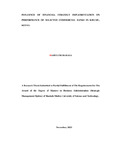| dc.description.abstract | Kenya witnessed collapse of several banks such as Imperial Bank and Dubai Bank regardless of the corporate aggressively building new competencies and capabilities, to remain competitive and grow profits. The study sought to determine the impact of Financial Strategy implementation, technological innovation, debt restructuring strategy on Performance of commercial banks in Kenya, ascertain the effect of financial risk management strategies on Performance of commercial banks in Kenya and to determine the moderating effect of organizational culture on the effect of Strategic Financial Management on Performance of commercial banks in Kenya. The research was directed by the theories of institutional theory, risk management theory, Burke-Litwin theory, and diffusion innovation theory. The research design used in this study was a descriptive survey. The research used 34 operational banks in Kisumu City as the target population, covering five years from 2017- 2021.The respondents consisted of 102 managers from the selected banks who were chosen via purposive sampling method. To collect primary data, structured questionnaires was used. A pilot study was carried out in four different commercial banks in Kakamega county to assess the validity and reliability of the research instruments that were being used where content, construct validities and Cronbach alpha were utilized for the purpose of determining reliability. Both descriptive and inferential statistics were employed to analyze the quantitative data. The descriptive analysis's findings were summarized and provided as a mean and standard deviation. To further examine this, an inferential analysis was performed using a 5% level of significance as the threshold. Descriptive analyses included things like frequency counts, standard deviations, and percentages, whereas inferential analyses made use of things like Pearson correlation analysis, simple linear, multiple linear, and hierarchical regression analysis at a significance level of 0.05 and a confidence level of 95.0%. Tables, charts, figures, and models were all available to access this information. Commercial banks in Kisumu City were shown to benefit from the deployment of financial technology innovation (β=.234, P=0.005), financial risk management (β=.280, P=0.005), and debt restructuring (β=.904, P=0.000). R squared = 0.727 indicates that 72.7% of the variance in commercial bank performance can be attributed to differences in financial strategy execution. Additional variance in performance of 4.8% (R Square change=0.048) was explained by the mediating influence of organizational culture on the link between financial plan execution and performance. Financial plan execution was shown to be a significant predictor of success for Kisumu City-based commercial banks. This research suggests that commercial banks should implement and enhance new technological innovations to boost their Performance, that commercial bank management should exercise oversight over the volume of credit and the collection strategy incorporated into its credit policy, and that bank administration should institute sound risk management mechanisms and policies to guide their operations. In addition, commercial bank management should put more resources into fostering activities that strengthen the institution's culture and ultimately boost performance. | en_US |

